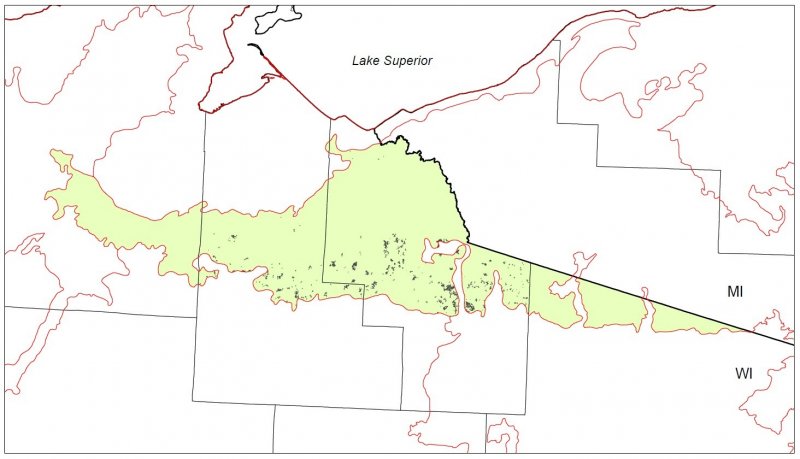
Natural Resources
Conservation Service
Ecological site F093BY001MI
Acidic Poor Fens
Last updated: 9/27/2023
Accessed: 12/21/2025
General information
Provisional. A provisional ecological site description has undergone quality control and quality assurance review. It contains a working state and transition model and enough information to identify the ecological site.
MLRA notes
Major Land Resource Area (MLRA): 093B–Superior Stony and Rocky Loamy Plains and Hills
The Wisconsin portion of this MLRA is a mixture of high-relief moraines and flat till plains with interspersed glacial meltwater deposits. It is bordered on the north by glaciolacustrine deposits of Glacial Lake Duluth and on the south by extensive pitted and unpitted outwash plains. The approximate land area is just under 600,000 acres (935 sq miles).
The Penokee-Gogebic Iron Range runs through the middle of the Wisconsin portion of this MLRA and into Michigian. The range is a hilly, bedrock-controlled moraine. The bedrock outcropping is composed of igneous and metamorphic materials and was created by inland folding and faulting of the ancient Superior continent when it collided with the Marshfield continent about 1.8 billion years ago (Dott & Attig, 2004). Volcanic and intrusive bedrock occurs in some places. This bedrock is overlain by a thin layer of glacial till deposited by the Chippewa Lobe.
To the north of the range is a former spillway for Glacial Lake Ontonagon. The flowing meltwater cut deep channels into the morainal systems. Glaciofluvial landforms here include old beaches and dunes. South of the range, along the southern edge of this MLRA, are rolling collapsed end moraines, pushed to their extent by the Chippewa and Ontonagon Lobes. The landscape is dotted with abundant kettle lakes and swamps, especially in the eastern portion. Ice-walled lake plains and eskers are also found along these collapsed moraines.
The climate is influenced by Lake Superior in areas near the lake, resulting in cooler summers, warmer winters, and greater precipitation – especially snowfall – compared to more inland locations. Historically, mixtures of eastern hemlock (Tsuga canadensis), sugar maple (Acer saccharum), yellow birch (Betula alleghaniensis), eastern white pine (Pinus strobus), and red pine (Pinus resinosa) covered the area. In wetter pockets (such as the swamps that dot the moraines to the south) white cedar (Thuja occidentalis), black spruce (Picea mariana), and tamarack (Larix laricina) were common (Finley, R., 1976).
Classification relationships
Relationship to Established Frameworks and Classification Systems:
Wetland Forest Habitat Types (Kotar, 2017): These sites are represented by Picea mariana – Larix laricina / Ledum groenlandicum (PmLLe) habitat type, with one outlier site as Abies balsamea-Fraxinus nigra-Thuja occidentalis/Ilex verticilata (AbFnThIx).
Biophysical Setting (Landfire, 2014): This ES is mapped Boreal Acidic Peatland System.
WDNR Natural Communities (WDNR (2015): This ES is most similar to the Black Spruce Swamp.
Hierarchical Framework Relationships:
Major Land Resource Area (MLRA): Superior Stoney and Rocky Loamy Plains and Hills, Eastern Part (93B)
USFS Subregions: Winegar Moraines (212Jc)
Small sections occur in the Gogebic-Penokee Iron Range (212Jb) subregion
Wisconsin DNR Ecological Landscapes: North Central Forest
Ecological site concept
The Acidic poor fens ecological site occurs primarily in the southern half of MLRA 93B in bogs and depressions almost exclusively in outwash plains. These sites are characterized by very deep, very poorly drained soils that formed in deep organic deposits of herbaceous origin. Some sites are underlain by sandy outwash. Sites are subject to rare ponding in the spring. Water is primarily received from precipitation and runoff from adjacent uplands, though limited groundwater discharge and stream inflow may contribute as well. Sites remain saturated throughout the growing season and meet hydric soil requirements. Soils range from ultra acid to strongly acid. These sites are wetlands.
Acidic poor fens are extremely acidic, much more so than their Organic Lowlands counterpart. The acidity is a result of limited interaction with groundwater that may be enriched with dissolved carbonates. In addition, the groundwater discharging into Acidic poor fens is likely passing through surrounding parent materials that are acidic (i.e. outwash sands as opposed to loamy morainal deposits). The extreme low pH limits vegetative growth.
Associated sites
| F093BY004MI |
Wet Lowlands Wet Lowlands occur on depressions and drainageways and form in loamy till or loamy alluvium underlain by dense sandy till or sandy and gravelly outwash. These sites are poorly drained and are higher up on the drainage sequence than Acidic poor fens. They typically border Acidic poor fens |
|---|---|
| F093BY005MI |
Moist Lowlands Moist Lowlands occur on footslope positions across the landscape. They are not subject to flooding nor ponding. Soils form in till, lacustrine deposits, or outwash deposits and may be loamy to sandy. These sites are somewhat poorly drained and occur higher on the drainage sequence than Acidic poor fens. |
| F093BY011MI |
Dry Uplands Dry Uplands are found in the sandiest, most permeable soils on the driest landscape positions. They are very deep and excessively drained and occupy the highest position on the drainage sequence, whereas Acidic poor fens occupy the lowest. |
Similar sites
| F093BY002MI |
Mucky Swamps Like Acidic poor fens, Organic Lowlands consist of deep herbaceous organic material, are very poorly drained, and remain saturated throughout year. They also occupy landscape depressions and the lowest positions on their drainage sequences. Organic Lowlands are more alkaline than Acidic poor fens and, as a result, the vegetative communities on these two sites are quite different. |
|---|
Table 1. Dominant plant species
| Tree |
(1) Picea mariana |
|---|---|
| Shrub |
Not specified |
| Herbaceous |
(1) Ledum groenlandicum |
Click on box and path labels to scroll to the respective text.
Ecosystem states
State 1 submodel, plant communities
| 1.1A | - | Site disturbance; increase in ponding; wind/ice damage |
|---|---|---|
| 1.1.B | - | Increase in ponding frequency/duration |
| 1.2B | - | Decrease in ponding frequency/duration |
| 1.2A | - | Increase ponding frequency/duration |
| 1.3.A | - | Decrease in ponding frequency/duration |
